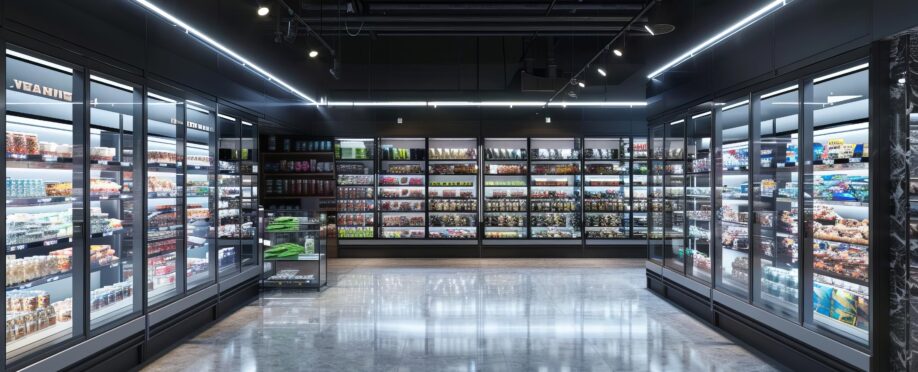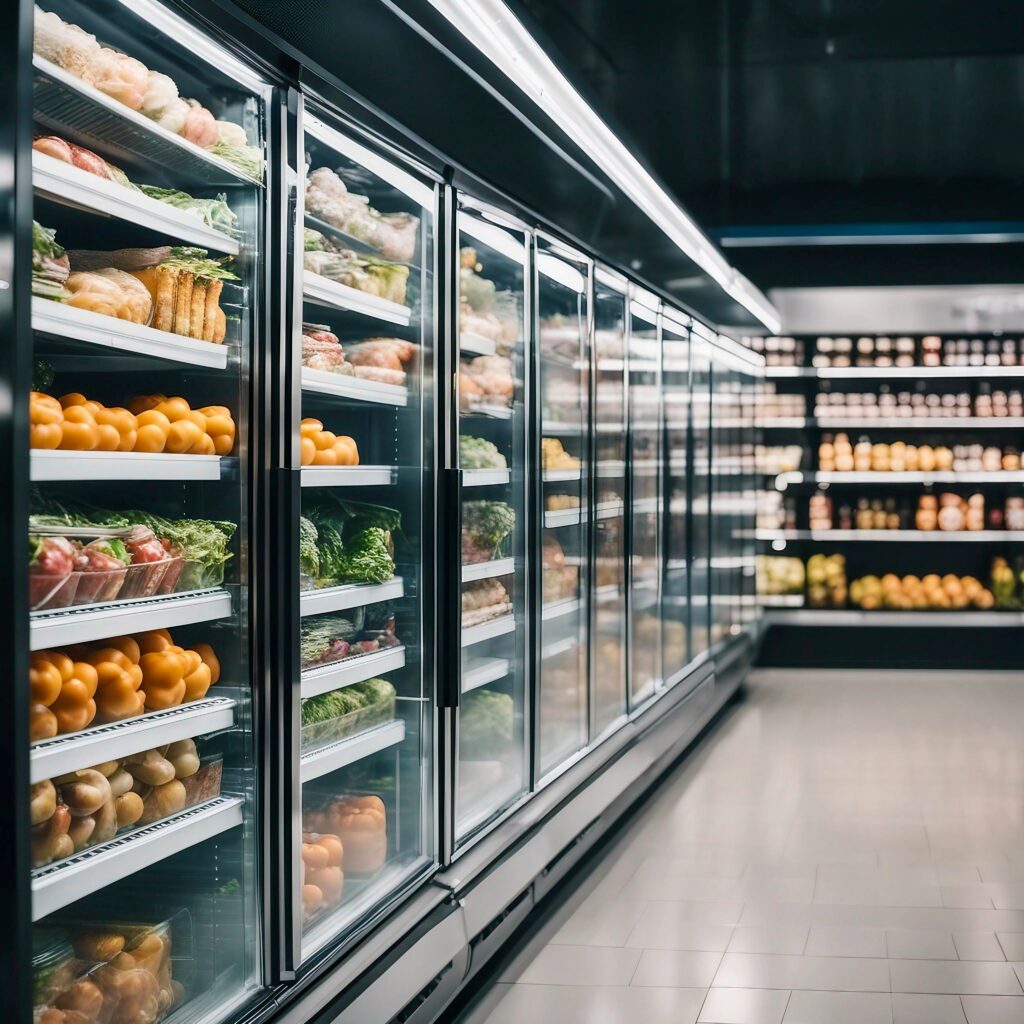
A historic shift is underway for supermarkets and food retailers who rely on refrigeration technologies, as sweeping new federal legislation aims to substantially curb greenhouse gas emissions from legacy cooling systems. This change stands to affect thousands of grocery stores nationwide.
With the ambitious American Innovation and Manufacturing (AIM) Act setting the aggressive and legally binding goal of phasing down potent climate-damaging hydrofluorocarbon (HFC) refrigerants by 85 percent over 15 years, facility management leaders must urgently mobilize teams to uphold seamless daily operations amidst these mounting regulatory disruptions.
This article helps retail FM teams fully decode the intricacies of AIM Act and its upcoming HFC phase-outs, map out detailed reduction schedules, assess the implications, and proactively leverage available incentives.
What Is the AIM Act?
In a rare bipartisan effort, 2020’s AIM Act established a staggered timeline for substantially restricting both the domestic production and the use of ubiquitous hydrofluorocarbon (HFC) refrigerants. These refrigerants are currently utilized as cooling agents across most supermarket refrigeration systems nationwide.
What Are HFCs?
HFCs are predominantly used as heat-absorbing coolants due to their potent capacity to rapidly absorb and slowly release immense amounts of thermal energy. These gasses can be hundreds to thousands of times more effective at trapping heat in the atmosphere through the greenhouse effect than carbon dioxide. Phasing out unrestrained HFC supplies aligns U.S. environmental policy with the Montreal Protocol’s Kigali Amendment.
The AIM Act and the Montreal Protocol
The Montreal Protocol is an international agreement endeavoring to protect the Earth’s ozone layer. When the Kigali Amendment was added in 2016, 197 nations pledged to fight climate change by phasing down high global warming potential (GWP) chemicals internationally.
The AIM Act provides the essential regulatory framework for the United States to uphold its international climate commitments. With the AIM Act directing the EPA to enact staggered domestic production cuts of 10 percent to 85 percent for HFCs across four separate reduction stages through 2036, sweeping refrigeration equipment change has now arrived for thousands of HFC-reliant food retailers nationwide.
For example, under the phasedown, leading HFCs like R-404A and R-507A — both of which are commonly used in cooling — will soon face major restrictions constraining servicing and top-offs. Meanwhile, equipment that relies on these refrigerants will be entirely prohibited from manufacture and installation within the coming years. The reality of this staggered phasing out highlights the urgent need for transition planning.
AIM Act Phasedown Schedule
With the context of what’s driving this legislation now established, let’s examine the detailed multi-year phasedown schedule for scaling back domestic HFC supplies:
- AIM Act: 85 percent EPA HFC cut by 2036
- EPA Regulations: ~10 to 85 percent reductions from 2022 through 2036
- Kigali Amendment: 85 percent HFC reduction by 2047
As HFC production declines in order to adhere to these deadlines, food retailers that are significantly reliant upon cooling must methodically transition both new construction retail store designs as well as existing stores to lower-global warming potential (GWP) refrigerant alternatives. The GWP alternatives must be explicitly approved for use within each compliance date window.
Given the major implications on critical food refrigeration equipment, retail facility leaders should closely follow the gradual yearly tightening of legal refrigerant GWP limits. Understanding the schedule enables retailers to strategically plan equipment changes over a 5- to 10-year timeframe — balancing sustainability goals, asset management, and budgets.
The Impact of the AIM Act on Refrigeration
The AIM Act and its supporting EPA rulings are fundamentally transforming the future of refrigeration for grocery stores and food retailers of all sizes. By necessity, the legislation aims to phase out the high-GWP HFCs that are most prevalently used as today’s refrigerants. Next-generation, low-emissions alternatives will soon replace these legacy coolants.
In preparation for these changes, retail facility leaders must closely monitor how the staggered EPA production cuts will affect these key areas of impact:
- Refrigerant availability: Sources of commonly used coolants will drastically decline on a set schedule, thereby requiring the appropriate transition of equipment. R-404A and R-507A face initial servicing restrictions beginning in 2022 and ending with a 2025 phase-out.
- Compliant replacements: As HFC supplies drop, retailers must adopt lower-GWP refrigerants like R-454A or R-448A, both of which are currently approved by the EPA for new equipment installations going forward. Additionally, natural refrigerants like CO2 (R-744), ammonia (R-717), and hydrocarbons (e.g., propane R-290, isobutane R-600a) are becoming popular choices in the RHVAC industry.
- Asset procurement strategy: The phasedown requires retailers to align equipment upgrade and replacement cycles with compliance timelines to avoid ending up with outdated assets.
- Refrigerant management: Strict usage caps and leak checks for remaining high-GWP gasses require intensive refrigerant tracking and compliance documentation.
Careful refrigeration road mapping for the decade ahead is now essential in order to navigate these regulatory hurdles and take full advantage of energy efficiency opportunities.
AIM Act Compliance Deadlines
To avoid disruptions during these changes in acceptable refrigerants and supplies, retail operators must proactively track and prepare for major AIM Act deadlines. These include:
- 2023: EPA allots significantly lower HFC production volumes, spurring initial coolant scarcity.
- 2025: Further HFC cuts begin, thereby affecting pricing as supply tightens further.
- 2027: The transition accelerates with an HFC allowance of just 20 percent compared to peak levels.
- 2030: Another 35 percent reduction widens equipment compliance gaps as key dates still loom.
- 2036: The final 60 to 85 percent reduction forces the prohibition of outdated refrigeration that’s lingering past optimal replacement timeframes.
While complete phase-out targets don’t culminate until 2033 for leading HFCs and 2035 for R-404A specifically, experts are urging retailers to begin converting centralized rack architecture within the next 1 to 3 years, given the long lead times to be expected.
While the AIM Act targets specific deadlines, it’s important to stay informed about evolving EPA guidelines, as the requirements for specific refrigerants could change based on market availability and policy updates. Check the latest EPA information on a regular basis to ensure full compliance as these timelines progress.
To learn more, read our guide on the latest EPA refrigerant regulations.
Cost Implications of the AIM Act
Proactively converting thousands of stores’ refrigeration infrastructures to meet these tightening emissions regulations will require significant upfront capital outlays, even from well-resourced grocery operators and supermarkets.
However, implementing compliant cooling systems into regular store renovations and new builds can provide retailers with significant cost savings in the long run:
- Energy efficiency upgrades: According to an EPA report, reducing energy costs by just 10 percent can lead to a 16 percent increase in profit margins for the average supermarket.
- Food waste reduction: Enhanced refrigeration temperature precision minimizes spoilage.
- Tax credits and rebates: Federal and state efficiency upgrade incentives can help offset costs.
When evaluating investments, facility teams should look at the total costs and benefits over the equipment’s life cycle. This involves comparing holistic cumulative savings against upfront capital requirements and ongoing part replacement/maintenance expenses. For regulation-compliant cooling equipment, the long-term cost savings and efficiency improvements make a strong business case for upgrading.

The AIM Act and Sustainability Goals
Going beyond just meeting legal requirements, grocery chains can use the transition as an opportunity to demonstrate their commitment to sustainability. Upgrading to greener refrigeration equipment can help organizations align with larger goals like net zero emissions and fighting climate change.
Environmental benefits include:
- Climate change mitigation: Phasing out high-GWP refrigerants reduces harmful emissions, thereby reducing their carbon footprint.
- Investor confidence: Improving energy efficiency as a result of upgrading outdated equipment can help grocery chains mitigate financial risks for stakeholders, as investors increasingly prioritize sustainability.
- Shifting consumer expectations: Younger demographics increasingly factor in sustainability when making purchasing decisions and choosing which brands to support.
Achieving compliance ahead of deadlines can help retailers boost their reputation and stand out from other brands, strengthening customer loyalty, community engagement, and talent acquisition and retention efforts, among other advantages, as a result.
AIM Act Support
As food retailers navigate the complex changes brought by new refrigerant regulations and sustainability goals, support and incentives are available to ease the financial burden of major equipment upgrades:
- Utility company rebates: Many electric utilities offer substantial rebates for grocery stores and supermarkets that install energy-efficient systems, such as high-efficiency refrigeration, lighting, and HVAC upgrades. By implementing multiple qualifying measures, businesses can receive enhanced rebates, increasing the standard rebate (typically 30%) by an additional 10%, significantly offsetting project costs and reducing overall grid demand.
- Energy tax credits: The federal government offers enhanced tax credits for eligible refrigeration technologies like variable speed compressors and evaporator fan controls that demonstrate specific year-over-year efficiency gains. These could potentially provide millions in annual energy tax relief.
- Sustainable refrigeration grants: Both state governments and private sector green technology financiers provide specialized grants and principal repayment assistance to fund trials of emerging sustainable refrigeration innovations across stores. These help reduce the risk of testing new equipment.
- Extended warranties: Top refrigeration equipment manufacturers typically offer extended parts and performance warranties on newer generation compressors, condensers, and cases engineered for maximum efficiency and emissions reductions. Such warranties help reduce lifecycle repair costs.
- Compliance financing assistance: Stores can leverage low-cost revolving lines of credit from green-focused financing partners to cover compliance costs. They can then pay back the debt through energy savings. This helps manage spending against budgets.
It should be noted that the availability of utility rebates and tax credits varies widely by state and utility provider. Reach out to your local representatives to learn more about the specific benefits available to you.
Let Our Refrigeration Experts Chart Your Custom Compliance Roadmap
Time is of the essence when it comes to taking advantage of the current opportunities available thanks to the latest emissions regulations, from energy efficiency improvements to solutions that positively impact your bottom line.
As strategic partners to the retail industry, the CBES team leverages the latest innovative technologies from across the globe to create fully customized refrigeration transition roadmaps for every store format and geographic footprint. Learn more about our sustainability services or contact our team today to get started.


 2016: City US is established in North America, in partnership with Southeastern Grocers (SEG), servicing over 750 supermarkets across 7 southern states.
2016: City US is established in North America, in partnership with Southeastern Grocers (SEG), servicing over 750 supermarkets across 7 southern states. 1985: Willie and Susan Haughey establish City Refrigeration Holdings (UK) Ltd in Glasgow, UK.
1985: Willie and Susan Haughey establish City Refrigeration Holdings (UK) Ltd in Glasgow, UK. 2009: City Australia launches in Melbourne, in partnership with Coles, servicing over 700 supermarkets across the country.
2009: City Australia launches in Melbourne, in partnership with Coles, servicing over 700 supermarkets across the country. 2015: City Asia launches in Kuala Lumpur, Malaysia, in partnership with Dairy Farm, servicing over 205 supermarkets across the region.
2015: City Asia launches in Kuala Lumpur, Malaysia, in partnership with Dairy Farm, servicing over 205 supermarkets across the region.